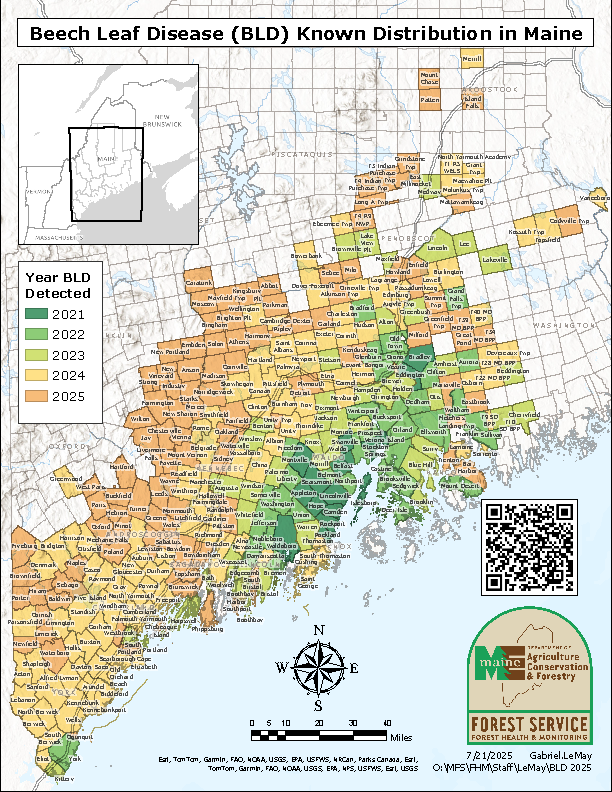DACF Home → Bureaus & Programs → Maine Forest Service → Forest Health & Monitoring → Invasive Threats to Maine's Forests and Tree → Beech Leaf Disease
Beech Leaf Disease in Maine
Beech leaf disease (BLD) was first described in Ohio in 2012. Since then, it has spread to the north and east, impacting beech trees wherever they are found. BLD was detected in Maine in 2021 in Lincolnville (Waldo County). Since then, the geographic distribution of BLD has increased markedly and it is now found in all of Maine's counties. BLD impacts all species, cultivars and ages of beech trees. Due to the relatively short time BLD has impacted beech trees in North America, much about the disease is still unknown, and BLD management and treatments are under trial and development. As new understanding of BLD develops, we will share information on this website and in our Conditions Reports bulletins.
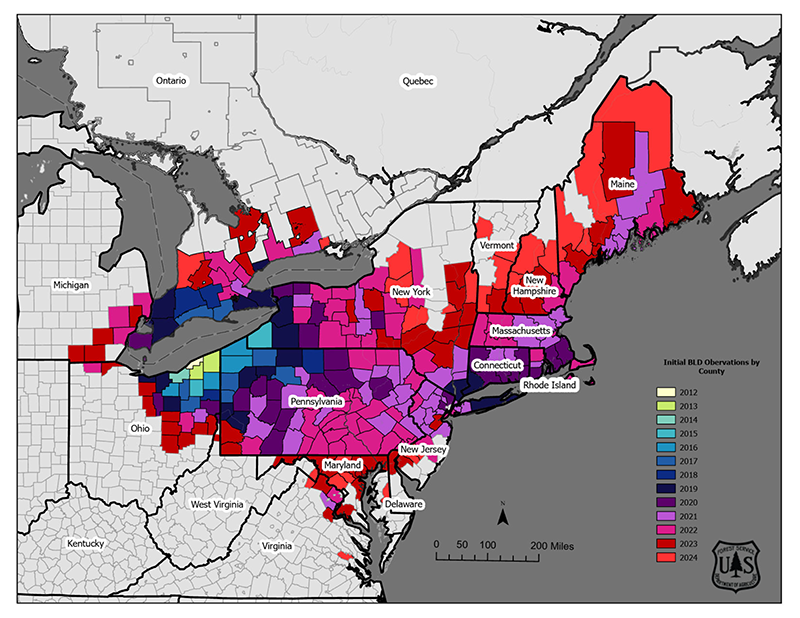
FAQs
What do we know about beech leaf disease? +
There is a lot that is still unclear about BLD. We do know:
- BLD can kill American beech, European beech, and many other beech cultivars of various origins;
- BLD symptoms are associated with the presence of a non-native foliar nematode (microscopic roundworm), Litylenchus crenatae mccannii;
- Disease symptoms tend to begin in smaller beech trees in the understory, however larger trees are also vulnerable to attack and decline;
- BLD may weaken beech trees over time, making them more vulnerable to secondary pests.
Close -
Which trees can get beech leaf disease? +
All beech trees (Fagus spp.) are susceptible to BLD, including European and Asian species (this includes beech cultivars available in the nursery trade).
Close -
Why is beech leaf disease a concern? +
American beech in Maine is already greatly impacted by a different invasive forest pest. The beech scale, introduced near the turn of the last century, makes beech vulnerable to attack from native fungi and the two together result in beech bark disease. This disease has made beech undesirable in the eyes of many who own and tend forests because thickets of diseased beech develop after some types of harvests. Even in this compromised state, beech plays an important role in Maine’s forests.
Beech is well known for producing beech nuts, the most nutritious of any of our hard mast species (‘hard mast’ is a general term describing nuts produced by forest trees, for example, oak acorns). Beech nuts are an important food source for many wildlife species. The early hairstreak, a rare butterfly; and the black bear, one of Maine’s iconic large mammals are two species that prefer beechnuts. Beech is also particularly important as a species that provides cavities for wildlife nesting or denning.
Even compromised by disease, beech is still used for wood products such as furniture and flooring among others.
More about American beech and wildlife (PDF | 3.61 MB) from the University of Maine and Maine Department of Inland Fisheries and Wildlife.
Close -
What information is missing about beech leaf disease? +
- How the disease spreads;
- Details of how the disease develops and impacts forest ecosystems and how that development is different in stands already ravaged by beech bark disease;
- Whether other organisms (bacteria or fungi for instance) are needed for disease development or if the nematode can cause disease without other agents;
- If there are other plants that could be impacted by the nematode or organisms associated with them;
- If there are effective ways to manage the disease (several methods are being tested for use in ornamental trees);
- If there are any beech trees with tolerance of or resistance to BLD.
Close -
What does beech leaf disease look like? +
Symptoms of BLD include:
- Dark bands between the veins of leaves;
- Leaves are cupped, deformed, shriveled and may be smaller than usual;
- Leaves can be thick and have a leathery texture, unlike the papery texture of healthy leaves;
- Premature leaf drop;
- Aborted buds leading to sparse leaf cover;
- Thinning canopy.
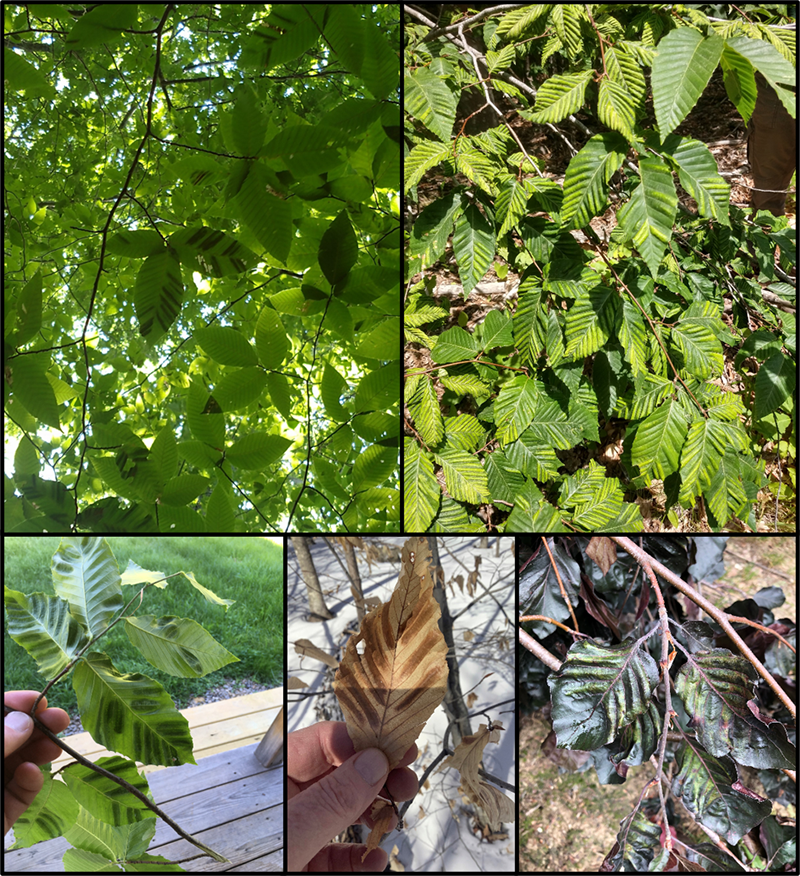
Images: (top left) Dark interveinal bands indicating BLD infection as seen looking up into the canopy from the understory; (top right) The full range of upper leaf surface symptoms from undersized leathery leaves to banding at various severity levels to asymptomatic leaves, all on the same branch; (bottom left) Dark banding and leaf deformation associated with BLD infection; (bottom middle) BLD symptoms as seen on winter leaves persisting on beech trees; (bottom right) European copper beech impacted by BLD, showing green discoloration, leaf deformation and interveinal banding.
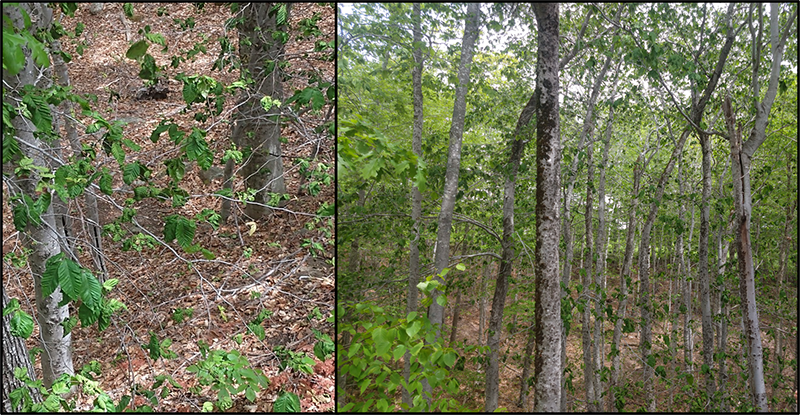
Close -
What else looks like beech leaf disease? +
There are several other organisms that can change how beech leaves look. Below are the most commonly encountered and reported BLD look-alikes in Maine.
Woolly beech aphid
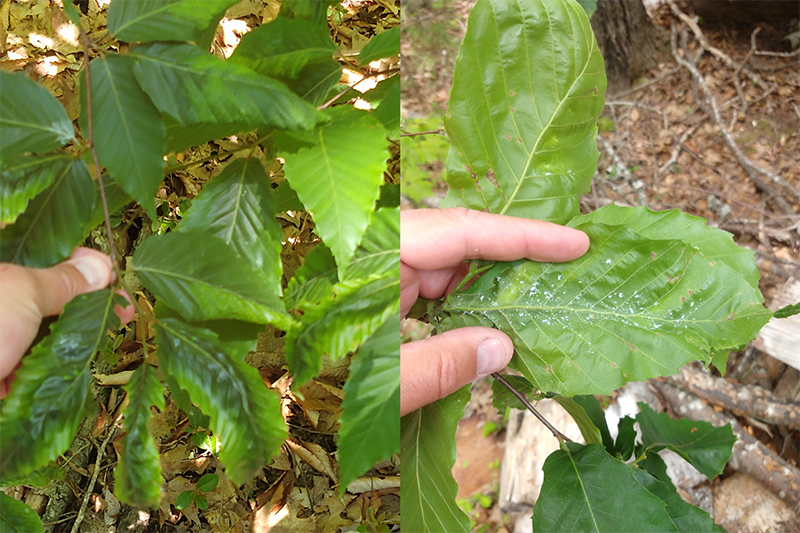
Woolly beech aphid (Phyllaphis fagi) causes leaf deformation and discoloration like BLD, however the leaves are often rolled or curled and do not show banding in between leaf veins like leaves impacted by BLD. Further, the discoloration from woolly beech leaf aphid is usually characterized by yellowing of the affected area and leaf margins. A clear sign of woolly beech aphid activity is the waxy filaments shed from the insects on the leaf underside. The damage caused by this pest is not serious and in most cases impacts the tree very little.
Erineum gall
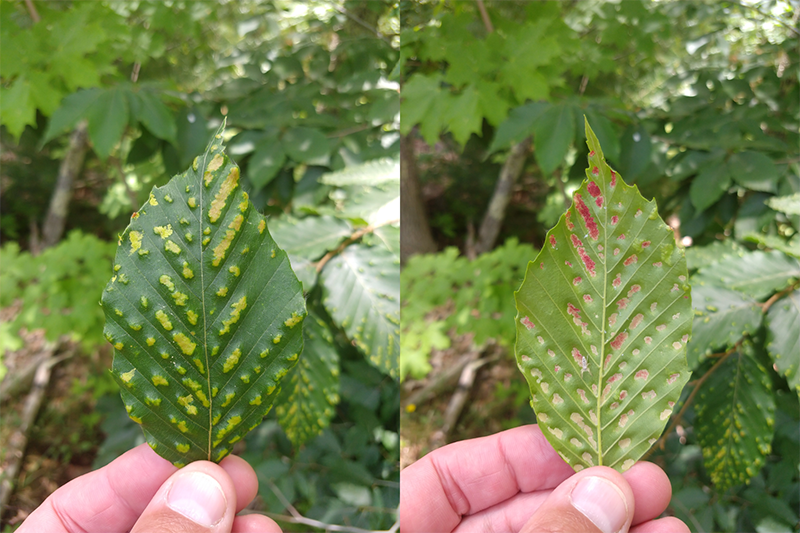
Erineum gall damage occurs interveinally (between veins) like BLD (left picture), however the banding is not dark, and white to red velvety patches (erineum) are typically seen on leaf undersides (right picture). The symptom is caused by the activity of microscopic eriophyid mites (family Eriophyidae) that alters leaf growth. The damage caused by this pest is not serious and impacts the tree very little.
Beech anthracnose
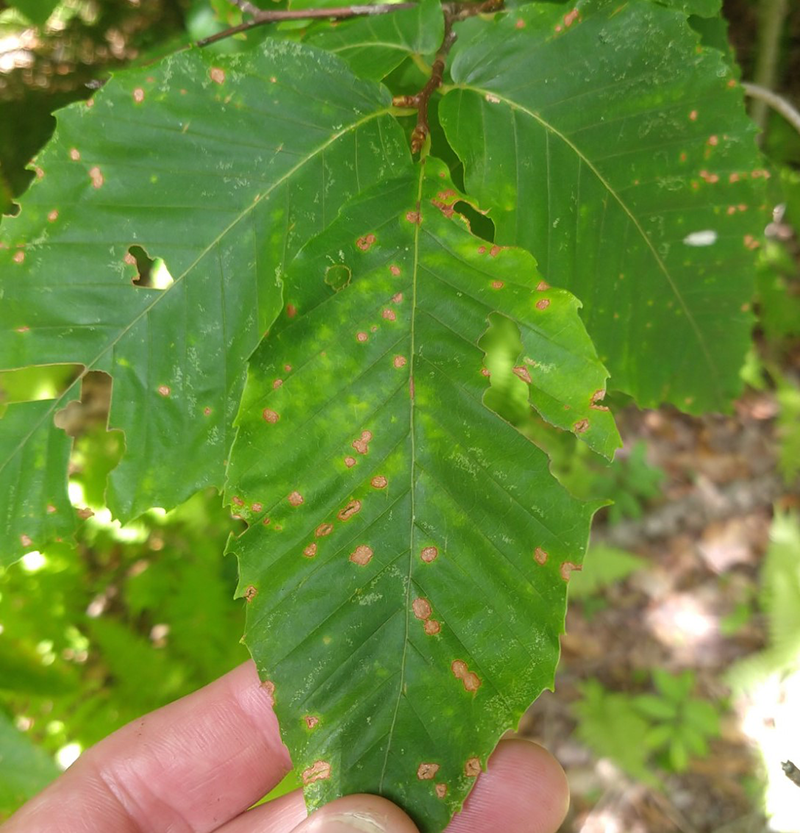
Beech anthracnose (Discula umbrinella) causes various degrees of discoloration and deformation of leaves like BLD, but the fungus causes lesions (often round) leading to dead brown leaf tissue surrounded by yellow discoloration of leaf tissue (a halo) and no banding is associated with beech anthracnose. When symptoms are much more severe than those pictured, beech anthracnose can cause significant defoliation.
When in doubt, please report it!
Symptoms and signs of BLD can vary, and unusual leaf symptoms could indicate other tree health issues. Also, BLD symptoms have been seen on the beech leaves impacted by other organisms, including these look-alikes!
Close -
How can I manage beech leaf disease symptoms in my trees? +
Researchers have been conducting a variety of BLD treatment trials over the past several years. Some encouraging preliminary results have been noted through these trials involving several products and modes of application. Here, three of the current and most promising applications are overviewed.
The most cost-effective BLD treatments to date involve the use of potassium phosphite products sometimes sold as fertilizers and other times as fungicides. The way these products work to manage BLD symptoms is not fully understood. Specific products are labeled for either soil drenching applications or for basal bark drench applications. Several phosphite products are available on the market and available to the public, including Agrifos, GardenPhos, Prophyt and Polyphosphite 30. These products are not restricted use substances, and can be purchased and used by homeowners and pesticide applicators. However, when these products are used to manage beech leaf disease, they are pesticides and pesticide regulations must be followed. Review the label and Safety Data Sheet on products for more information on their safe and effective use.
Maine Forest Service will continue to monitor developments as more is learned about BLD. The following management recommendations are still experimental but show promising results.
Basal Bark Drenches of Potassium Phosphite Products
A potassium phosphite treatment was highlighted in an update on beech leaf disease biology and management by The Connecticut Agricultural Experiment Station dated 14 May 2025. This is also a potassium phosphite-based treatment, but it is applied as a basal bark drench as follows:
- Make sure to always follow the label closely for best results and applicator safety.
- A potassium phosphite product labelled for use on beech trees is typically mixed with the appropriate amount of water and other materials as directed by the product label.
- The bark is wetted with the mixed product via a hand sprayer applied directly onto beech bark from the root flares at the base of the tree to a height calculated based on the diameter of the tree.
- For each inch of tree diameter measured at breast height (4.5 feet above the base of the tree ), the bark is drenched 1 foot in height. For example, a tree 5 inches in diameter will be thoroughly wetted with the mixed potassium phosphite product from the ground up to a height of 5 feet.
- For trees more than 10 inches in diameter, wet the bark to a height that is practical. For example, a 20-inch diameter tree could be thoroughly wetted to 10–12 feet.
- For each inch of tree diameter measured at breast height (4.5 feet above the base of the tree ), the bark is drenched 1 foot in height. For example, a tree 5 inches in diameter will be thoroughly wetted with the mixed potassium phosphite product from the ground up to a height of 5 feet.
- Apply once in earlier in summer and follow the same procedure one month following the first application (preferably both treatments are applied during May through August).
- Repeat annually. It may be several years before symptoms improve.
- Potassium phosphite products may harm nearby vegetation if exposed, so be sure to protect nearby vegetation and follow all environmental warnings associated with the applied product. Also, to ensure applicator safety, personal protection equipment must be used in accordance with the product label.
- Do not over-apply this product, as it may result in damage to trees.
Basal bark drenches of potassium phosphite are thought to work in the same way as the potassium phosphite soil drenches (mentioned below) and it is presumed more active ingredient is absorbed by the bark compared to soil applications, where some product may not reach the roots for absorption. Also, there are several basal bark drench products available for purchase by the general public. This is in contrast to the PolyPhosphite30 soil drench product that is not available for purchase by private citizens and is only sold to companies. Further, applying a potassium phosphite basal bark drench is generally quicker and more convenient compared to soil drenches – bark drenches are also said to be more effective in less time. Some basal bark drench products are listed in the linked bulletin from The Connecticut Agricultural Experiment Station found at the beginning of this section.
IMPORTANT: When considering these beech leaf disease treatment/management options, it is important to keep in mind that when a chemical is used in pest management, it is considered a pesticide and for-hire applications or applications in public areas need to be done by properly licensed commercial pesticide applicators.
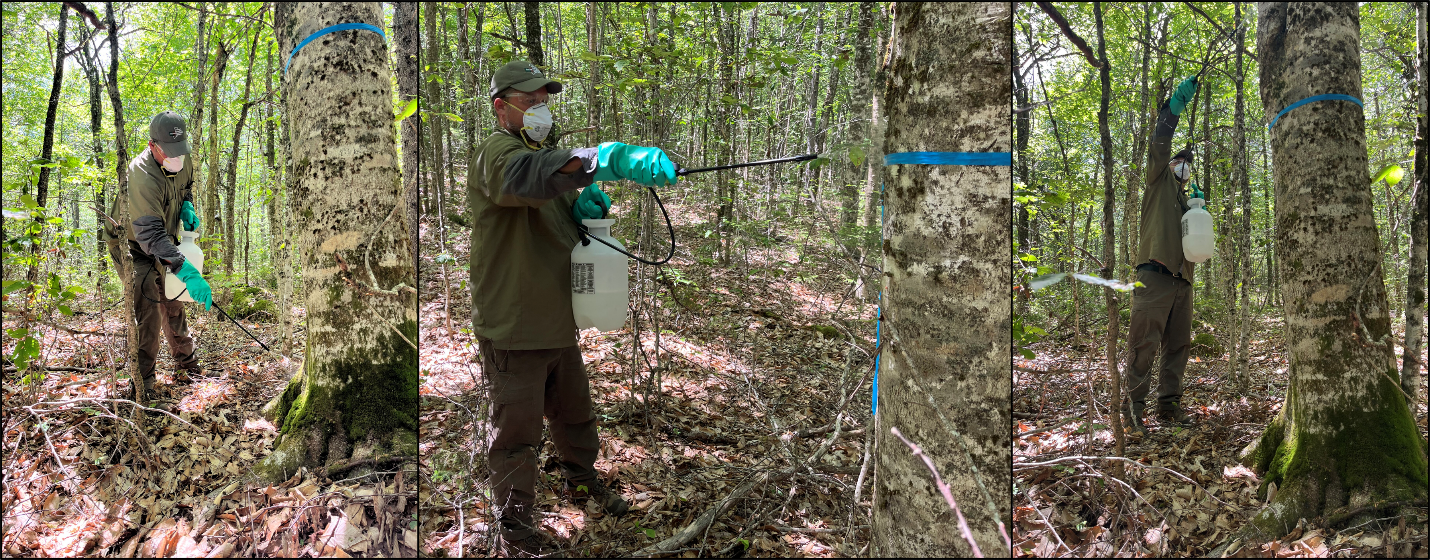
Soil Drenches of Potassium Phosphite Products
A soil drench method for BLD management has been trialed in Ohio since 2015 and has shown positive results there (results from two years of trials on three different size classes of trees in Maine have not yet shown positive results). The trialed treatment involved a specific soil-drench-applied potassium phosphite fertilizer called PolyPhosphite 30. Other soil drench products may be available for use and yield positive results, but only PolyPhosphite 30 was trialed in Ohio and showed positive impacts on the health of smaller-diameter beech trees (around 4–5 inches in diameter). Data on PolyPhosphite 30’s ability to limit BLD symptoms in larger trees is not available. Also, data on the effectiveness of other similar soil drench products has not been published. While these soil drench treatments do not eliminate BLD nematodes or completely prevent disease symptoms, they have been effective in decreasing nematode abundance and thus limit symptom severity, maintaining more of treated trees’ functional leaf area, presumably limiting the stress caused by severe BLD infestation. Two treatments are needed yearly, about one month apart, during the growing season (ideally apply soil drenches in June and July). Multiple years of treatments may be needed before clear results are seen. The following outlines the soil drench treatment procedure with PolyPhosphite 30:
- Make sure to always follow the label closely for best results and applicator safety.
- Measure the tree diameter at 4.5 feet above the ground (Diameter at Breast Height = DBH).
- For every inch of DBH dilute 2 oz of PolyPhosphite 30 in 14 oz of water.
- Example: for a 10-inch DBH (31.4-inch circumference) tree, mix 20 oz of PolyPhosphite 30 with 140 oz of water.
- Remove debris, leaf litter and other material from around the base of the tree and pour the mixture slowly to allow for good absorption of the product and prevent runoff from the target area.
- Where runoff is likely due to soil conditions or slope you can dig a shallow trench around the base of the tree and pour the solution into the trench. Be careful not to injure roots or the base of the tree.
- Apply once in early summer and follow the same procedure one month following the first application.
- Repeat annually. It may be several years before symptoms improve.
Potassium phosphite soil drench products can also be applied via specialized soil injection equipment. Directions for safe and effective use will be different for other similar products.
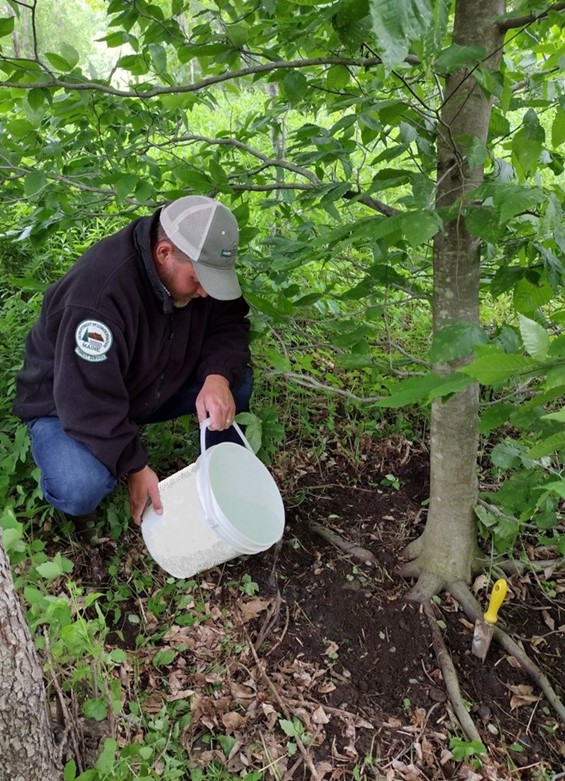
Macroinjection of Thiabendazole
The fungicide Arbotect 20-S with the active ingredient Thiabendazole has an approved Special Local Needs label in Maine for the treatment of BLD. This product is also used to prevent Dutch elm disease in elms. It is not certain exactly how Thiabendazole prevents BLD symptoms, but trials in other states have been promising when applied correctly via macroinjection. Two years of protection from symptoms has been observed in those trials. An application done in late June/July of Arbotect 20-S will not cure symptoms in the year of application but should limit symptom development for the following two years. Macroinjections done in August may show some symptom reduction in the year following application, but will not be expected to limit symptoms significantly until the 2nd spring after application. The reason for this is that the active ingredient must have time to be distributed throughout the tree and specifically be deposited in the newly forming buds well before the BLD nematodes exit current-year leaves and migrate to the pre-formed buds (which represent the leaves that will emerge next spring). Nematode feeding while overwintering in the beech buds causes damage that is manifested as symptoms seen when leaves emerge in spring. This method is much more expensive than the potassium phosphite-based applications and involves drilling multiple holes in the base of trees, but it does have a lasting effect (2 to 3 years) that may be appropriate for large, high-value landscape trees. Those interested in treating their beech via this method are encouraged to work with a licensed pesticide applicator experienced in using this technique.
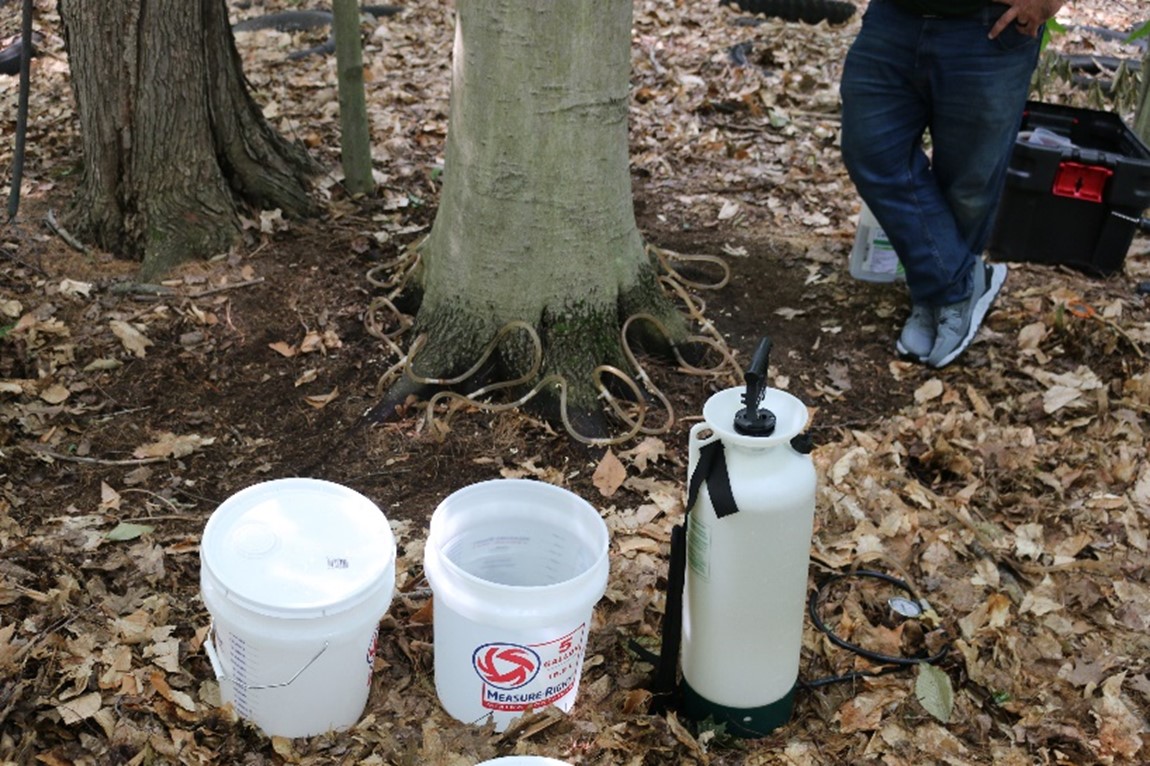
Cultural Practices
Pruning infected landscape trees may decrease the duration of foliar surface moisture and thus reduce BLD symptom severity since the causal agent nematode requires water for movement and other life processes. Water is particularly important during the time when BLD nematodes migrate from the current year’s leaves to the newly formed buds for overwintering (where nematodes feed and change plant cell structure and metabolism, leading to bud abortion and leaf symptoms seen in spring).
Thinning may also reduce symptoms. Thinning reduces competition and therefore promotes the health of residual trees that may be better able to persist under higher disease pressure. Thinning may also expose infected trees to more sunlight. Higher solarization enables quicker and more thorough drying of tree surfaces, limiting the BLD nematode’s ability to migrate and carry out other life functions.
Close -
Will all my BLD-infected trees die? +
At this time we are not exactly sure how BLD-caused decline and mortality will advance in Maine. The disease will likely be fatal to smaller trees in the shorter term, but the longevity of more mature trees is unclear. Since BLD was found in Lincolnville in 2021, the Maine Forest Service has been closely following disease progression and impacts on nine long-term monitoring plots using annual tree-health measurements. Monitoring efforts in 2023 did not record any mortality of mature trees in dominant or co-dominant positions in the forest canopy. Based on observations from other states that have had BLD longer, mature beech will also eventually die. The timeframe of decline sometimes leading to mortality for BLD-infested trees in the Lake States, for example, is about 5-7 years. Observations there have indicated that chronic stress caused by BLD has often led to attack by secondary agents of decline and mortality like root rots, canker fungi and insects. In these cases BLD has not directly killed beech trees but has been a major contributor to mortality. The presence of beech bark disease in Maine’s forests may significantly influence the rate of decline of beech trees also infected with BLD.
Close -
The trees in my yard are infested with BLD, should I cut them down? +
Tree removal is left to the discretion of the landowner. Trees infected with BLD can persist for several years depending on their general vigor, with lower-vigor trees typically declining more quickly. The impacts of BLD often reduce tree services like shade and aesthetics such that removal and replacement are practical decisions. Also, as trees decline and eventually die, they may develop rot that makes them less structurally stable. Removal should be considered for trees near structures or in high-use areas.
Close -
The trees in my woodlot are infested with BLD, should I cut them down? +
Pre-emptive harvest of beech is not recommended. Oftentimes genetic diversity within tree populations leads to varying impacts from pests and diseases. A great example of this is seen in American beech either tolerant of or resistant to beech bark disease. Reactive harvesting can reduce or eliminate genotypes that show disease tolerance or resistance.
Research efforts on BLD management strategies, including silvicultural trials, are underway and could provide useful information towards addressing BLD-impacted stands. Landowners and land managers should carefully consider their beech resources and have a plan in mind in the event that practical measures to manage BLD are not found and trees continue to decline. If beech eventually die due to the impacts of BLD infection, some trees could be left for cavity-nesting wildlife, as they provide excellent habitat for several species.
Close -
If I cut down trees infested with BLD, what should I do with the leaves, branches and wood? +
In the yard setting, the best thing to do with all plant material that is infested with BLD is to keep it on site and not transport it to new areas. Composting or burning leaves on site is recommended (make sure to acquire a Maine Forest Service Open Burn Permit). Since the threat of spreading BLD on wood and branches is unclear, precaution should be exercised. Chipping or burning branches is recommended. Wood chips from BLD-infested trees are safe to use on site. Use the firewood from harvesting BLD-infested beech locally, preferably on site.
In the forest setting, beech branches and other plant material should be left on site. There are currently no regulations concerning the movement or processing of BLD-infected wood. The most cautious approach would be to limit movement of beech material harvested from infected stands to areas already known to have BLD.
Close -
Are there any other precautions I can take to prevent the spread of BLD to new areas? +
While more is being learned about BLD’s mode of spread, there are still many unanswered questions. Natural resource organizations in some states where BLD is found have encouraged people to clean their boots in between moving from sites where BLD is present to other areas, as BLD nematodes and their eggs could be transported in plant material, for example, stuck in muddy boots or on tools and equipment. Cleaning boots, tools and equipment before heading to new sites, trails, etc., is typically a good practice to prevent the transport of invasive plant seeds and other unwanted organisms like jumping/snake (Amynthas) worms.
Moving any plant material from the genus Fagus (the beech family), especially living trees, seedlings or saplings, is strongly discouraged due to the potential to spread BLD to new areas.
Close -
Where can I report beech leaf disease? +
The Maine Forest Service is asking for the public’s help in identifying additional areas impacted by BLD. Photos of suspected symptomatic leaves can be submitted via our online form; reports can also be made to foresthealth@maine.gov or by calling (207) 287-2431. If possible, photos should include a clear shot of the underside of an affected leaf or leaves, however, please report concerns even if those photos cannot be provided.
Close -
Where can I learn more about beech leaf disease? +
The USDA Forest Service has developed a Pest Alert on the disease (PDF | 2.19 MB), and Don’t Move Firewood have informative pages.
Close -
